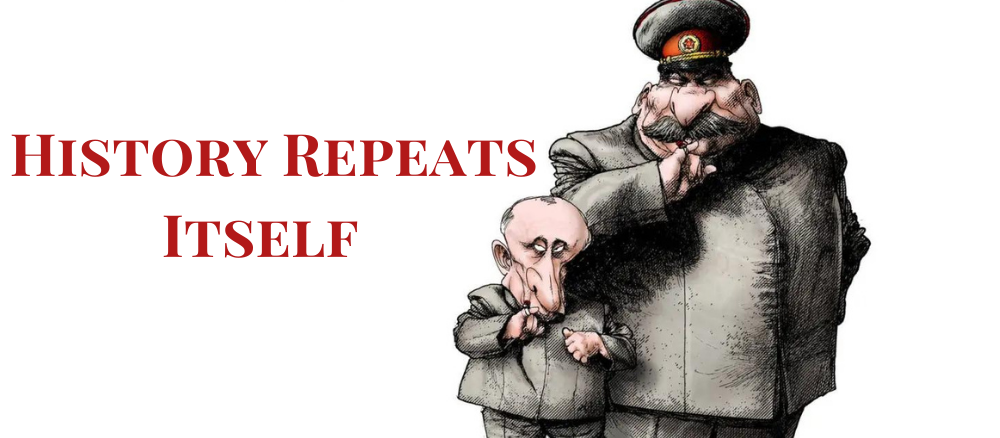
Written by Mike Quirk
Russia’s brutal invasion of Ukraine is a stark illustration of history repeating itself while at the same time ensuring President Vladimir Putin will forever be remembered for the murder and mayhem he inflicted on innocent peace-loving people.
Putin will never match the death toll of former Soviet dictator Joseph Stalin, who ruled by terror and was responsible for the death of millions (many his own citizens) between 1929 and 1953.
But the blood on the current leader’s hands, with his unprovoked attack on neighbouring Ukraine, will forever link him to Stalin who launched a similar bloody cross-border assault on Finland 83 years ago.
Like Putin, Stalin’s war against Finland, was aimed at expanding the Soviet Union’s territory, but the similarities went further including the killing of civilians and the dogged fightback by the outnumbered defenders who initially mauled the attackers and sent them scarpering away to “regroup”.
Inexperienced and badly led Russian troops faced the same embarrassing whipping at the start of the current war as their Soviet “brothers” did in Finland in 1939.
The Winter War, also known as the First Soviet- Finnish War, began on November 39, 1939, three months after the outbreak of WWII.
The Soviet Union had earlier signed a non-aggression pact with Nazi Germany, leaving it free to follow in Hitler’s footsteps who sparked WWII by invading neighbouring countries to expand German territory.

Despite daunting superior military strength, especially in tanks and aircraft (the Soviets initially had 800 planes backing some 300,000 troops against 130,000 Finnish soldiers and 100 planes, many of which were not battle worthy), the Finns inflicted a series of resounding and humiliating defeats on the enemy.
The Finnish soldiers – use to the forest, efficient hunters, skilled on skis, natural fighters and committed patriots – showed themselves to be master practitioners of the art of irregular warfare.
To add to the Red Army’s problems, it was not prepared for the exceptionally cold winter of 1939-40 with temperatures dropping as low as -45deg F.
Like the current Ukraine war, Stalin ordered civilians in cities and towns to be targeted. Soviet planes bombed Finland’s capital Helsinki on the opening day of the war reportedly killing up to 1000 men, women and children.
Accurate figures of Russian losses in the war are not available (much like Ukraine today), but the Red Army lost about 27,500 dead against a total figure of 2,700 Finnish dead and wounded. The Finns also reportedly captured 80 tanks and 70 guns and rounded up 1,600 prisoners. Some reports suggested Soviet losses were greater.
Like in Ukraine, the Soviet High Command made grave blunders, most notably the suicidal tactic of arrogantly sending armoured and motorised columns nose-to-tail along roads where there was no possibility to manoeuvre and ideal for ambush.
(Hitler is reported to have noted the incompetence of the Soviet military leadership and soldiers in the Winter War – contributed to by Stalin’s purge of the Red Army’s officer corps in 1937-38 when deciding to invade the Soviet Union about 18 months later).
The Soviets could not continue to suffer such big losses against the Finns so their forces, like Putin’s soldiers, withdrew and regrouped under a new commander with massive new reinforcements being brought in.

Early in February, 1940, the overwhelming power of the new offensive in Finland had its first major success and others followed.
In early March, the vastly outnumbered and outgunned Finns, who were running short on ammunition, sued for peace and on March 12, 1940, the Russo-Finnish Treaty was signed in Moscow with swathes of Finn land handed to the Soviets.
To date, the defiant Ukrainians are not look following Finland’s path.
Ironically, considering Putin’s warning of “consequences” if friendly countries continued sending Ukraine arms and ammunition, the Soviet Union welcomed such help from the Allies when Hitler ordered the invasion of the Soviet Union in June,1941.
About 1400 merchant ships tackled the dangerous Norwegian Sea and Arctic Ocean between 1941 and 1945 to deliver essential supplies to the Soviet Union under the Anglo-Soviet agreement and US Lend Lease program, escorted by the Royal Navy, Royal Canadian Navy and the US Navy.
Eighty-five merchant vessels and 16 Royal Navy warships were lost helping the Soviet Union repel the Nazis.
SheSociety is a site for the women of Australia to share our stories, our experiences, shared learnings and opportunities to connect.

Leave a Reply